Highlights from the Rosetta mission thus far
When Rosetta deployed the lander, Philae, to the surface of comet 67P/Churyumov-Gerasimenko on 12 November 2014, the mission had already accumulated a significant number of successes.
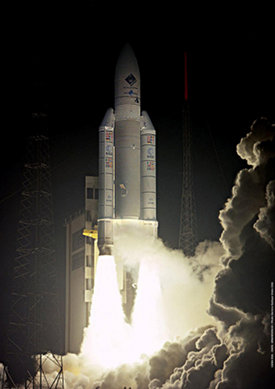 |
| Liftoff of an Ariane 5 G+ on 2 March 2004 carrying Rosetta. Credit: ESA/CNES/ARIANESPACE-Service Optique CSG, 2004 |
The idea that became Rosetta was conceived in the early 1980's even before ESA's Giotto mission flew by comet 1P/Halley, returning the first detailed picture of a comet's nucleus ever seen. The success of Giotto meant that plans for a follow-on mission were enthusiastically considered.
Almost 20 years later, Rosetta was built, tested and ready to launch. But disaster struck just one month before the planned liftoff. In December 2002, an Ariane 5, similar to the one designated to launch Rosetta, failed while lifting a communications satellite into orbit. With one billion Euros of tax-payers money and the hopes of the world's comet scientists resting on the successful launch of Rosetta, the difficult decision was made to postpone the attempt until the launcher failure was understood.
This robbed the mission of its original target, comet 46P/Wirtanen. While the engineers worked to understand and prevent the loss of another Ariane 5, scientists and engineers searched for a replacement target. Eventually they settled on comet 67P/Churyumov-Gerasimenko, a somewhat more massive comet than Wirtanen. This led to the strengthening of the legs on Rosetta's lander Philae, to cope with the slightly faster landing speed now expected.
With all this drama behind it, the first highlight of the mission was simply to leave the surface of the Earth behind and begin its interplanetary journey. The launch took place on 2 March 2004.
A complex journey
Rosetta could not head straight for the comet. Instead it began a series of looping orbits around the Sun that brought it back for three Earth fly-bys and one Mars fly-by. Each time, the spacecraft changed its velocity and trajectory as it extracted energy from the gravitational field of Earth or Mars. During these planetary fly-bys, the science teams checked out their instruments and, in some cases, took the opportunity to carry out science observations coordinated with other ESA spacecraft such as Mars Express, ENVISAT and Cluster.
Each of the fly-bys required months of intense preparation. In particular the fly-by of Mars in February 2007 was a critical operation: the new mission trajectory to 67P/Churyumov-Gerasimenko required that Rosetta fly past Mars at just 250 km from the surface, and spend 24 minutes in its shadow.
The spacecraft had been designed for the mission to Wirtanen, which did not include a period in Mars's shadow. The flight team had to re-programme the spacecraft completely in the months preceding the Mars fly-by, teaching Rosetta "not to worry" and to avoid potentially catastrophic autonomous reactions to the absence of sunlight on the solar panels and Sun sensors.
When the Rosetta signal reappeared after the passage behind Mars, shortly after the end of the "shadow" period, there was a collective sigh of relief.
Getting to know Rosetta
More than a decade has passed since Rosetta was launched. This meant that by the time it arrived at the comet in 2014, it was an old-timer in terms of starting its main mission phase. Nevertheless, it had to work at peak efficiency to make the most use of the months it would have at the comet.
One advantage of the mission's 10-year cruise phase is that the flight team has had plenty of opportunities to become familiar with many aspects of the spacecraft's personality. No matter how precisely designed and constructed, all complex machinery takes on a life of its own once it starts working. Spacecraft are no different.
In the case of Rosetta, the flight team has learned to use the thrusters at slightly reduced efficiency to compensate for the fact that the fuel tanks cannot be re-pressurized. This is due to a leak in the Reaction Control System that manifested itself in 2006.
They have also learned to operate the reaction wheels at lower speeds than originally designed. The reaction wheels are critical to the mission. They are used to orient the spacecraft such that the instruments can point to the comet, the solar arrays to the Sun, and the main antenna to the Earth. Well into the mission, two out of the four reaction wheels started showing signs of vibrations when operated at their normal operating speed. An alternative software has been devised that uses only two wheels; this is ready to be uploaded and used in case the two reaction wheels completely fail.
The cruise phase has not been all quiet. Even in the periods of low activity, during the long arcs between fly-bys, the spacecraft had to be monitored once a week, and its flight plan continuously updated.
Science along the way
En-route to the comet, Rosetta encountered two asteroids. These allowed the scientists and flight team to practise with the instruments and to gain more valuable experience about how to navigate the spacecraft. A highlight from the first encounter was Rosetta executing a manoeuvre that had originally been termed too risky.
Asteroid Steins is tiny, just 5 kilometres across; about the size of a large village. On 5 September 2008, Rosetta was to fly past at a distance of 800 kilometres, roughly the distance between Paris and Munich, and keep everything in the sharpest focus possible. To do this throughout the fly-by would have meant exposing one face of the spacecraft to the Sun for longer than allowed.
The original strategy defined by the spacecraft manufacturer, taking into account Rosetta's thermal and mechanical constraints, involved stopping before the closest approach to turn the spacecraft back to its nominal attitude. This would have led to significant loss of data. Naturally, the data-hungry scientists wanted to take observations all the way through.
 |
| Mosaic of images of Asteroid Steins. Credit: ESA ©2008 MPS for OSIRIS Team MPS/UPD/LAM/IAA/RSSD/INTA/UPM/DASP/IDA |
So the flight control team invented and tested a new strategy, such that Rosetta tracked the asteroid autonomously all the way through the encounter, boosting confidence in the spacecraft enormously.
However, not everything went according to plan. The OSIRIS science camera and the navigation cameras did not work exactly as expected during the fly-by revealing another quirk of the spacecraft's personality. The team worked out how to ensure this did not happen again so that the next fly-by would be a success.
This paved the way for the mission's most celebrated science highlight prior to arriving at comet 67P/Churyumov-Gerasimenko: the fly-by of asteroid Lutetia in July 2010.
Whereas Steins was a small jumble of rocky debris that resembled a solid object, Lutetia was a miniature world, with a diameter of 130 kilometres. At the time, it was the largest asteroid ever seen in close-up.
Rosetta was going to fly past at a greater distance, 3162 kilometres this time in order to allow the full asteroid to appear in the field of view of the scientific cameras. Nevertheless, the spacecraft would be out of communications with Earth for about 40 minutes as it turned its attention to Lutetia.
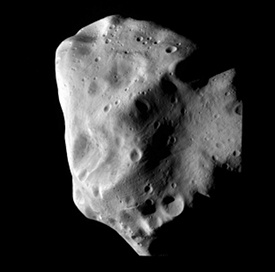 |
| Lutetia at closest approach., Credit: ESA 2010 MPS for OSIRIS Team MPS/UPD/LAM/IAA/RSSD/INTA/UPM/DASP/IDA |
The vigil was worth it. Rosetta began streaming back its data, revealing a mini-world of the most complex geology. Its pulverised surface appeared to be poor in metals but showed the presence of hydrated minerals. There were rockslides and giant craters covering this battered relic from the formation of the Solar System.
In terms of aesthetics, the beauty-shot was an image that Rosetta had snapped on approach, showing the looming bulk of the asteroid in the foreground. In the distance, more than ten thousand times further away from the spacecraft, was the unmistakable shape of Saturn and her rings.
Rosetta sped on. It had charged past the asteroid at a relative speed of 54 000 kilometres per hour and was heading for the comet. Even at that great speed, there were still four more years to go. This meant that the moment many of the mission team dreaded was almost upon them: hibernation.
Hibernation and then …
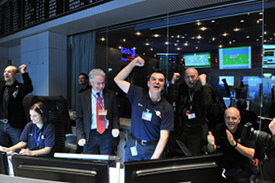 |
| Rosetta is awake! Credit: ESA - Juergen Mai. |
Putting Rosetta to sleep for two years, seven months and twelve days was forced on the mission because it had to go so far out into the Solar System. Rosetta carries large solar panels based on completely new technology that makes them exceptionally efficient. But so far from the Sun, where no solar-powered spacecraft has gone before, there would not be enough power to keep all the spacecraft's systems operating. So everything was shut down, except for the on-board computer, some internal heaters and a few clocks to count down until 10:00 UTC on 20 January 2014. Then it was time for Rosetta to wake up, reactivate its communications system and phone home.
It did so, after a tense 18 minute delay, caused by the on-board computer rebooting. A memorable moment for the assembled scientists, flight team, officials and press, and a significant highlight ticked off the list. The mission was alive and ready for business. Next stop: the comet itself. Not that the flight team could relax. There was still a lot to do.
Destination in sight
Between wake-up and rendezvous, all twenty-one instruments had to be brought online and checked out. Software was updated and the spacecraft had to perform a series of 10 manoeuvres to reduce its speed sufficiently to rendezvous with the comet rather than fly by it.
The final arrival manoeuvre took place on 6 August 2014. During the preceding few weeks, as Rosetta approached the comet, it became increasingly obvious that the mission to orbit and land on the comet was going to be more difficult than anyone had imagined because of the comet's unexpected shape.
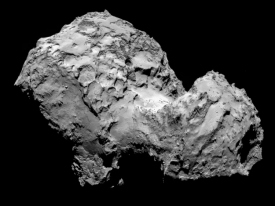 |
| Comet 67P/Churyumov-Gerasimenko on 3 August 2014. Credit: ESA/Rosetta/MPS for OSIRIS Team MPS/UPD/LAM/IAA/SSO/INTA/UPM/DASP/IDA |
Instead of the expected 'potato' form, 67P/Churyumov-Gerasimenko was revealed to be a double-lobed structure with a 'head' and a 'body' separated by a narrow neck – some people have even likened the shape to that of a rubber duck.
The rendezvous with the comet took place with Rosetta at a distance of about 100 kilometres. This was too far away for the comet to hold the spacecraft with its weak gravitational field. The flight team executed a series of manoeuvres, known as pyramid trajectories, to steer Rosetta towards the comet. During this time, they studied how Rosetta responded to the weak but complex gravitational field generated by the comet's odd shape, while at the same time scientists gathered data to characterise the comet.
Gradually the distance between Rosetta and the comet was reduced until the spacecraft was captured by the comet's gravitational field on 10 September. At that point it was just 30 kilometres from the surface. After that, Rosetta edged even closer, at times getting as close as 9 kilometres from the centre of the comet.
Preparing for landing
In tandem, the Rosetta team was searching for a place to set down Philae. This too was complicated by the comet's shape. By 24 August 2014, using data collected when Rosetta was still about 100 km from the comet, five candidate regions had been identified for further analysis; three were on the head and two were on the body.
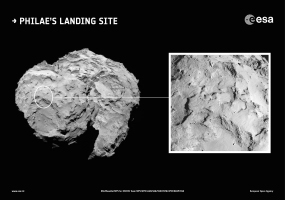 |
| Philae's primary landing site in context. Credit: ESA/Rosetta/MPS for OSIRIS Team MPS/UPD/LAM/IAA/SSO/INTA/UPM/DASP/IDA |
All were more difficult terrains than hoped. Cliffs, craters, and boulders populate each of the sites. A detailed analysis of Philae's capabilities and the opportunities offered by each site revealed that the best choice was a location originally referred to as Site J, and later named Agilkia.
On 12 November 2014, Rosetta deployed the Philae lander to the surface of comet 67P/Churyumov-Gerasimenko. Philae was released at 08:35 UTC/09:35 CET, and touched down (for the first time) about seven hours later. Confirmation of the landing arrived at Earth at 16:03 UTC/17:03 CET.
Soon it became apparent that not everything had gone to plan. Instead of anchoring itself to the comet, Philae had bounced. The touchdown had triggered the science sequence to start and so the first readings were taken as the lander drifted across the comet's surface.
The instruments Ptolemy and COSAC detected gas and dust, showing that both contained carbon- and nitrogen-rich organic compounds, some of which had never been discovered on comets before. Among this collection were molecules that play a key-role in the synthesis of amino-acids, sugars and DNA's nucleobases. In other words, the building blocks of life.
The fact that these compounds are found on a primitive comet signals that they were present at the start of the Solar System, when the planets were forming. This could well be showing us the ingredients that became life on Earth.
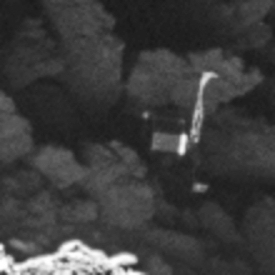 |
| Philae at Abydos. Credits: ESA/Rosetta/MPS for OSIRIS Team MPS/UPD/LAM/IAA/SSO/INTA/UPM/DASP/IDA |
Philae eventually came to rest angled up against a cliff face in the comet's Abydos region. Here the MUPUS suite of instruments showed that the surface was harder than at the Agilkia site, where the lander bounced.
For most of the remaining time of the mission, the exact location of Philae was unknown – radio ranging measurements had tied down its location to an area spanning a few tens of metres, but no definitive proof of its location had been uncovered. During 2015 and 2016 the search had continued when opportunities arose. Finally, on 2 September 2016, an image taken with the OSIRIS narrow-angle camera, within 2.7 km of the surface, showed the lander wedged into a dark corner of the comet. Knowing the location has provided the final pieces of information needed to put Philae’s three days of science into their proper context.
The surprising comet
Meanwhile in orbit, data from the instruments on Rosetta show the comet to be one surprise after another.
During Rosetta's approach to the comet in 2014, the MIRO instrument registered that between June and August, the amount of water vapour being released by the comet increased by a factor of ten.
 |
| First measurements of comet 67P's water ratio. Credits: Spacecraft: ESA/ATG medialab; Comet: ESA/Rosetta/NavCam; Data: Altwegg et al. 2014 and references therein |
Early readings from the ROSINA instrument showed that the water on the comet was substantially different from the water on Earth. The difference with Earth's water is apparent in the ratio of deuterium to hydrogen atoms in the water. Deuterium is a heavier isotope of hydrogen. It contains a neutron particle as well as the normal proton. When deuterium combines with an oxygen molecule, it is known as heavy water. On Earth there are roughly 160 molecules of heavy water for every million molecules of the normal stuff. ROSINA found that the amount of deuterium on 67P was greater by a factor of three.
Combining this result about the comet water with observations of molecular nitrogen and oxygen, and also the Noble gas argon, indicates that the comet is ancient, being made from the cold components of an interstellar cloud rather than a warmer nebula surrounding the forming Sun. It could well be that some of the constituents of 67P are unaltered since before the formation of the Solar System.
The ratio of dust to gas has been studied by comparing the amount of both being emitted, and this shows the comet to be more of an icy dust ball. This "dryness" also constrains the likely location of formation of the comet.
In August 2015, Rosetta followed 67P through its closest approach to the Sun. More surprising results followed. The largest chunks seen being thrown from the comet by OSIRIS were greater than 1 metre in size near perihelion. Before then, they were only around 1 centimetre.
Despite passing as close to the Sun as it ever gets, finding 67P's active regions has been an unexpected challenge. There is a lot of activity on the comet that gives birth to the surrounding cloud of dust and gas, known as the coma, but the mechanics of this activity is still being investigated and is proving a great challenge.
Computer models suggest that escaping water vapour must come from a nearly uniform distribution of dirty water ice spread across the comet's nucleus. However, the Hapi region has shown itself to be more active than other areas. More collimated activity has been tracked back from the coma to the location of pits and cliff edges, where ice deposits have been identified. During perihelion some very large, 'explosive' enhancements in the coma were seen. Combining these observations with modelling is a major activity, with scientists trying to reconcile the different mechanisms at play.
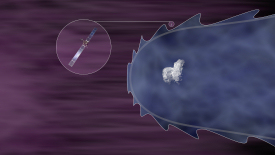 |
| Artist's impression of the magnetic field-free region found by Rosetta at comet 67P. Credit: ESA–C.Carreau |
The outflowing coma interacts with the solar wind – a stream of charged particles continuously flowing from the Sun. As activity grows, these interactions become more intense and create a cavity, 'shielding' the nucleus from the solar wind. Such a cavity was expected to stand in front of the comet by only a few 10's of kilometres, but observations by the Rosetta Plasma Consortium have found that it is much more dynamic, its boundary reaching more than 180 kilometres from the comet. A new breed of wave interaction has been discovered by Rosetta and has been coined the 'comet sound'. How this interaction changes over time is still being investigated.
To study the internal structure, the CONSERT experiment passed radio waves through the nucleus between the lander and the orbiter. It showed that the porosity of the 'head' of the comet is very high – about 75-85%. This is consistent with a very loosely compacted mixture of dust and ice, termed a 'rubble pile'. This observation was also supported by studies, by the Radio Science Investigation team, of the way the Rosetta orbiter is pulled by the gravity of the comet, which allowed them to infer the porosity of 67P.
The high porosity suggests that the comet's formation was a relatively gentle affair with many small 'cometesimals' falling together at speeds of less than 1 metre per second. This would mean that they 'rested' against each other rather than melting into a single slab.
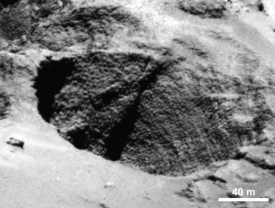 |
| Close-up of pit wall with 'goose bumps'. Credit: ESA/Rosetta/MPS for OSIRIS Team MPS/UPD/LAM/IAA/SSO/INTA/UPM/DASP/IDA |
Tantalisingly, OSIRIS has seen pits 100 metres wide and deep. Visible in the walls are 'goose bumps' about 3 metres in diameter. Computer models suggest that the original cometesimals would be about this size. So, could these be the original building blocks that accumulated 4.6 billion years ago to become 67P/Churyumov-Gerasimenko? Time and further investigation will help answer this question.
Rosetta's mission is set to continue until 30 September 2016. At this time the comet will be around 3.6 times further from the Sun than the Earth is. This is the distance at which Rosetta finds it increasingly difficult to generate enough power from its solar panels to keep functioning.
Mission controllers are planning to set the spacecraft down on the dusty, icy surface of the comet. They are targeting Ma'at, a region hosting some active pits on the small comet lobe. This region has been chosen for its scientific potential and taking into account the operational constraints involved in carrying out the descent. Although the data collecting will then be over, the analysis and investigation will continues for decades to come.
Clearly, it is not just the double-lobed structure of 67P that marks it out as an individual. Its composition, density and behaviour all suggest that we must substantially revise or even re-write our ideas about comets. Our understanding of comets, the formation of the Earth and other planets will never be the same again thanks to Rosetta and Philae.
